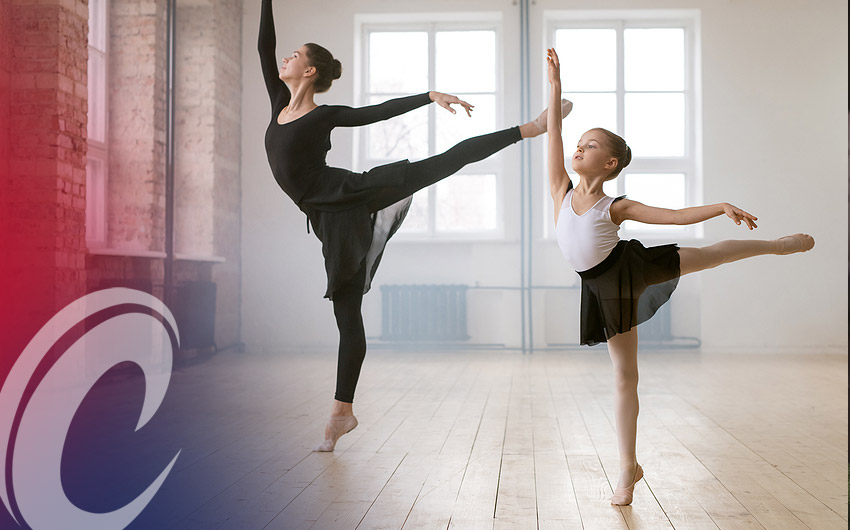Have you ever heard a dance instructor tell one of her students to get lower or get your knee over your toes? Sounds easy, but it may not always be the case. These types of dancers may not physically be able to get lower due to either strength deficits or lack of mobility or flexibility. The end result is a tall dancer who bends more at the waist or hips instead of getting low enough by bending the knees and the ankles to get a strong, powerful stride.
Dancers spend most of their dancing time with our feet pointed, known as plantar flexion. Because of the amount of time they spend with feet pointed, the result may be an imbalance in ankle mobility and limited range of motion when a dancer’s foot is in dorsiflexion or flexed upward.
There’s little doubt that pain in the ankle is quite often ignored by dancers. The way the ankle moves or doesn’t move can not only affect the joint causing pain and injury but can also limit a dancer’s ability to get in certain positions needed to be successful in their performance. Mobility in the joint is the ability of the joint to move through a range of motion both unloaded and loaded. In other words, a dancer may be able to gain certain range of motion, but can they do it while jumping, landing, or pushing off. These motions are important in dance and other sports.
The ankle does not have to be injured to lose mobility. Mobility in the ankle is the range of motion in the joint both weighted and unweighted and with the knee straight and bent. In healthy dancers, this mobility can be restricted by tight muscles in the calves. This can be due to recent growth spurts, an increase in intensity during dance or training such as running or jumping or just body type.
There is a myth that you should never get your knees over your toes. Look at most dancers and other athletes when they run, skate, dance, and jump. The knee slightly or sometimes extremely goes over the toes. When performing simple movement patterns such as squats or lunges, the knees need to go slightly over the toes to engage the proper muscles to maximize performance.
There are two major muscle groups that affect ankle mobility, the soleus and the gastrocnemius. Both muscles plantarflex the ankle as in performing a calf raise. In dancers, they assist in jumping and dancing as the movement typically finishes with the push off at the ankle. The big difference between the two is that the soleus originates below the knee whereas the gastrocnemius originates above the knee. Knowing this is important, because the dancer will need to stretch the ankle with both the knee straight and the knee bent.
So how do you know if your ankle mobility is restricted? A simple test is to place your foot flat on the ground and pointing forward with your toes approximately three inches from the wall. You should be able to squat down a bit, bending your ankle forward (dorsiflexion) and touch your knee to the wall without lifting your heel or your ankle rolling inward. In this position, the front leg which is being tested, should have some weight on it and you should be able to bend down and forward getting the knee over the toes. Check both sides and look for symmetry. If you are unable to perform this easily, you may have limited ankle mobility.
Why is it important for a dancer to have improved range of motion in their ankles?
- Decreased risk of injury
- Peak mobility – better movement in your ankles for footwork patterns
- Optimal stability – more stability = improved power
If you have failed the test mentioned above, there are a few simple things you can do to improve your ankle stability.
- First, use a foam roll or lacrosse ball and roll out your calves from your Achilles all the way up to your knee to loosen the soft tissue. Then repeat the testing procedure, also known as ankle rocks ten times pausing each time you have rocked forward.
- Add a calf stretch as well by placing your foot flat on the ground behind you with a straight leg, feeling the stretch up higher this time. Hold this stretch for 15 seconds.
- Repeat these steps three times daily on the road to increased ankle mobility and better, more graceful dance moves.
No one wants to be that injured dancer. No dancer wants to miss time, let down the troupe, be unavailable to win the upcoming competition or not get the next big role.
Deciding between usual dancer discomfort and more serious problems can be challenging. Don’t take on that challenge by yourself. If concerns are on the floor, look at teaming with a sports medicine specialist as a way to add, not subtract from your dance experience. It’s always good to work with a healthcare professional such as an Athletic Trainer to make sure the dancer is doing movements correctly.
Chris Phillips is an Athletic Trainer, Strength and Conditioning Specialist and Sports Safety Specialist with over 25 years’ experience in professional hockey, football, dance, cheerleading, and soccer. Chris has worked with hundreds of professional, Olympic and Hall of Fame athletes and is the owner of Compete Sports Performance and Rehab in Lake Forest, California. For more information, visit http://competesportsperformance.com/.

